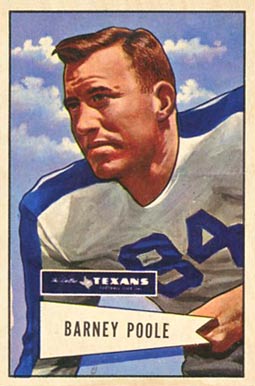| No. 58, 84, 62, 83, 78 | |
 Poole on a 1952 Bowman football card | |
| Date of birth | October 29, 1923 |
|---|---|
| Place of birth | Gloster, Mississippi, U.S. |
| Date of death | April 12, 2005 (aged 81) |
| Place of death | Gloster, Mississippi, U.S. |
| Career information | |
| Position(s) | End |
| US college |
Ole Miss North Carolina Army |
| NFL draft | 1945 / Round: 6 / Pick: 53 |
| Drafted by | New York Giants |
| Career history | |
| As player | |
| 1949 | New York Yankees ( AAFC) |
| 1950–1951 | New York Yanks |
| 1952 | Dallas Texans |
| 1953 | Baltimore Colts |
| 1954 | New York Giants |
| Career highlights and awards | |
| Career stats | |
| |
George Barney Poole (October 29, 1923 – April 12, 2005) was an American football end in the National Football League (NFL) for the New York Yanks, the Dallas Texans, the Baltimore Colts, and the New York Giants. Poole also played football in the All-America Football Conference (AAFC) for the New York Yankees. Poole played college football at the University of Mississippi, where he was an All-American as an offensive and defensive end. He was inducted into the College Football Hall of Fame in 1974.
Barney Poole was preceded in the NFL by two brothers, Jim "Buster" Poole and Ray Poole, both of whom had long professional football careers. Barney Poole was one of the few players who played college football for more than four years, because his two years with the national championship Army team were not counted against his collegiate eligibility.
NFL Hall of Famer Art Donovan shared this anecdote about Poole, his teammate with the 1953 Colts: "Early in my career—the Colts' first year back in Baltimore, as a matter of fact—I played with a defensive lineman named Barney Poole. He was a tough guy, but by 1953 he was pretty much over the hill. And he was doing anything he could to hang on. In one game he tore up his hand. He caught his fingers in someone's face mask and it nearly yanked a couple of the digits out. That hand was a mess. This happened sometime early in the second quarter, and Barney was led off the field and into the locker room and soon thereafter an ambulance carried him off to Union Memorial. He got his fingers stitched up. I swear to God, he got out on Thirty-third Street and hitchhiked right back up to Memorial Stadium. Damned if he didn't return in time to play the fourth quarter. And he did play, too, with a big wrapping on those twisted and mangled fingers. He was one tough player, and the Colts rewarded him the following season by cutting his ass." [1]
See also
References
- ^ Donovan, Arthur (1987). Fatso: Football When Men Were Really Men. pp. 158–159. ISBN 0-688-07340-9.
External links
- 1923 births
- 2005 deaths
- People from Gloster, Mississippi
- Players of American football from Mississippi
- American football ends
- American football defensive ends
- Ole Miss Rebels football players
- North Carolina Tar Heels football players
- Army Black Knights football players
- College Football Hall of Fame inductees
- New York Yankees (AAFC) players
- New York Yanks players
- Dallas Texans (NFL) players
- Baltimore Colts players
- New York Giants players
- Coaches of American football from Mississippi
- Alabama Crimson Tide football coaches
- American football defensive lineman, 1920s birth stubs